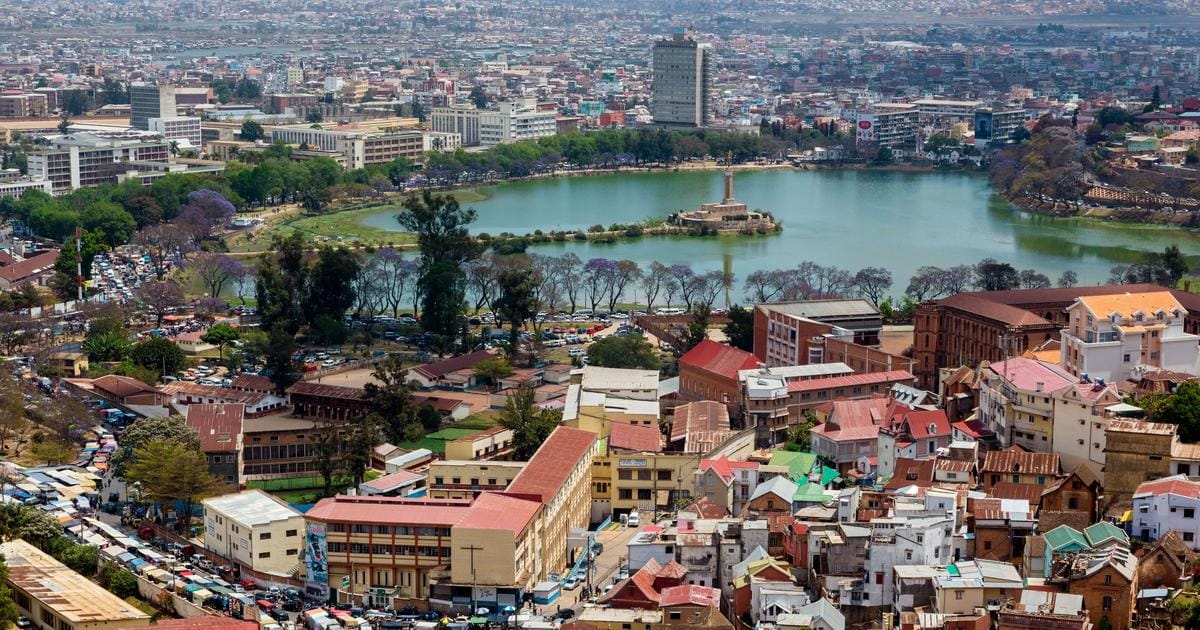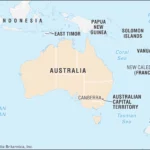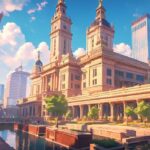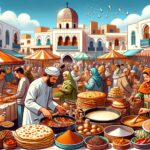Prepare yourself for an extraordinary adventure to the heart of Madagascar’s capital city, Antananarivo! This vibrant metropolis invites you on a thrilling journey through its rich history, diverse culture, and captivating natural beauty. Join us as we guide you through its lively markets, unravel the secrets of its historical landmarks, and savor the irresistible flavors of Malagasy cuisine. Experience the allure of this captivating city as we unlock its hidden wonders, leaving an unforgettable imprint on your soul. Embark on this literary expedition and discover the essence of Antananarivo, where the heart and soul of Madagascar truly reside.
Capital of Madagascar: A Journey Through the Heart of an Island Nation
Antananarivo, the capital of Madagascar, is more than just a name on a map; it’s a city pulsating with life, history, and a distinctive fusion of cultures. Perched over 4,000 feet above sea level, it offers breathtaking panoramic views.
As the former seat of power for the Merina Kingdom, Antananarivo’s history is deeply intertwined with its royal heritage. This legacy is evident in the city’s architecture and the palpable sense of history that pervades its streets.
But Antananarivo isn’t frozen in time. It’s a modern metropolis that thrives as Madagascar’s economic powerhouse. Bustling markets overflow with colorful spices, juxtaposed against modern buildings reaching for the sky.
Culturally, Antananarivo is a haven for artists, musicians, and intellectuals. Universities attract bright minds, while theaters and art galleries pulsate with creativity. The city’s nightlife is electric, offering something for everyone.
Like any major urban center, Antananarivo faces challenges such as overcrowding and pollution. However, city planners are actively addressing these issues, recognizing the importance of balancing progress with preservation for a sustainable future.
Visiting Antananarivo is an experience of contrasts: ancient palaces stand in the shadows of contemporary art, the scent of exotic flowers mingles with the aroma of street food. This sensory tapestry will captivate your imagination and leave a lasting impression.
To get a list of Canadian cities and their capitals, check this out.
Would you like to know the capital of Kazakhstan?
What is the capital of Albania?
Explore the beautiful capital of Cambodia and discover its rich culture.
Do you know what is the capital of Norway?
Nestled in the Himalayas, discover the enchanting capital of Bhutan.
Have you ever wondered about the capital of Taiwan?
What is the Capital of Madagascar?
At the heart of Madagascar lies Antananarivo, affectionately known as “Tana.” Nestled in the highlands, this bustling city is not only Madagascar’s largest city but also its political, economic, and cultural nerve center.
As the former capital of the Merina Kingdom, Tana’s history is deeply embedded in its foundation. This rich past can be felt while exploring the reconstructed royal palaces and sacred martyr churches.
Tana is a city of contrasts. Modern skyscrapers share the skyline with traditional architecture, reflecting the city’s dynamic energy and growth. Whether you’re drawn to its thriving arts and culture scene, its renowned universities, or its lively nightlife, Tana’s energy is contagious.
The city faces challenges familiar to rapidly growing urban areas, such as overcrowding and pollution. However, efforts are underway to address these issues and ensure a sustainable future for this unique city.
Imagine strolling through a bustling market, the air thick with the aroma of exotic spices. Friendly vendors beckon you closer, their lively chatter creating a symphony of sound. Later, you savor delicious Malagasy dishes, a fusion of flavors reflecting the island’s rich heritage. This is Antananarivo—a city that’s constantly buzzing, full of contrasts, and undeniably captivating.
How do you pronounce the capital city of Madagascar?
The name “Antananarivo” might seem like a mouthful, but mastering its pronunciation is easier than you think. Take it slow, syllable by syllable: “Ah-ntah-nah-nee-ree-voh.”
To add a touch of authenticity, emphasize the second and fourth syllables: “Ah-ntah-nah-nee-ree-voh.”
The name “Antananarivo” translates from Malagasy, the language spoken in Madagascar, to “City of Thousands.” It’s a fitting name for a city brimming with history, culture, and a whole lot of character.
Is Madagascar part of Africa or India?
Madagascar’s location in the Indian Ocean often sparks the question: does it belong to Africa or India? While its proximity to India might suggest a connection, Madagascar is officially considered part of Africa.
Geographically, Madagascar sits on the African tectonic plate, a fundamental link to the African continent. Historically, Madagascar has had more interactions with mainland Africa, including trade, cultural exchange, and migration, further weaving a strong thread between them.
The people of Madagascar have also politically aligned themselves with Africa, solidifying Madagascar’s place as an African nation.
However, Madagascar’s long isolation from both Africa and India has resulted in a unique ecosystem and biodiversity. Approximately 75% of the species found in Madagascar are endemic, meaning they are found nowhere else on Earth. This incredible biodiversity makes Madagascar a true natural wonder.
Culturally, Madagascar is a melting pot of influences. The Malagasy language, for example, exhibits both Austronesian and Bantu influences. Over the centuries, African and Asian traditions have intermingled, creating a vibrant and unique cultural tapestry in Madagascar.
Key Takeaways:
- Although situated in the Indian Ocean, Madagascar is officially part of Africa.
- Its incredible collection of unique plants and animals is a testament to its long isolation.
- Madagascar’s culture is a vibrant mix of African and Asian traditions.
- The people of Madagascar have chosen to align themselves politically with Africa.
Why is Madagascar famous?
Madagascar stands out as a truly unique destination, boasting extraordinary features that set it apart.
One of its most celebrated attributes is its wildlife. Lemurs, those adorable primates with big eyes, are like the island’s ambassadors. Chameleons, masters of disguise, blend seamlessly into their surroundings. And then there’s the fossa, a cat-like predator unique to Madagascar.
What makes these creatures even more special is that they are found nowhere else on Earth, making Madagascar their sanctuary. Madagascar is a biodiversity hotspot with an estimated 75% of its species being endemic.
The island’s landscapes are just as impressive, ranging from lush rainforests teeming with life to towering mountains and dry, spiny deserts. And of course, no mention of Madagascar’s landscapes would be complete without mentioning its beautiful beaches.
Madagascar’s people and their culture are an integral part of the island’s allure. A vibrant mix of African, Austronesian, and French influences has created a unique cultural tapestry. From music and dance to traditional crafts, the spirit of Madagascar is woven into every aspect of life.
What makes Madagascar so special?
It’s the unique combination of one-of-a-kind wildlife, diverse landscapes, and a rich, vibrant culture. It’s like stepping into a completely different world. And the best part? Scientists are still discovering new things about Madagascar all the time. Who knows what other secrets this incredible island holds?
Is Madagascar a rich or poor country?
This is a complex question. While Madagascar boasts abundant natural resources, it remains one of the poorest countries in the world. This apparent paradox underscores the challenges Madagascar faces in translating its natural wealth into widespread prosperity.
Factors such as political unrest, corruption, and a struggling economy hinder Madagascar’s ability to fully capitalize on its resources. It’s a country with immense potential, but unlocking that potential requires addressing deep-seated issues.
While Madagascar’s economy has experienced some growth, primarily driven by tourism and exports, this growth hasn’t translated into enough well-paying jobs to significantly impact the poverty rate.
Efforts to address these challenges are underway, focusing on stabilizing the political landscape, tackling corruption, and creating more economic opportunities for the Malagasy people. However, the journey towards economic stability and prosperity is a complex and ongoing process.
Here’s a quick recap:
- Despite being rich in natural resources, Madagascar faces widespread poverty.
- Political instability, corruption, and a lack of economic opportunity contribute to this complex issue.
- Economic growth doesn’t always directly translate into a better quality of life for everyone.
Is Madagascar Capital Safe?
Safety is an important consideration when traveling to any new destination. Like many major cities, Antananarivo has experienced a rise in petty crime, including pickpocketing, bag snatching, and theft from cars. There have also been reports of more serious crimes, which is concerning.
Several factors likely contribute to this issue, including political instability and a struggling economy.
However, this doesn’t mean a trip to Antananarivo is out of the question. By taking sensible precautions and staying informed, you can have a safe and enjoyable experience.
Here are some tips for staying safe:
- Be Aware in Crowded Places: Markets, festivals, and busy streets are often targeted by pickpockets. Keep your belongings close and be aware of your surroundings.
- Exercise Caution at Night: As with many cities, avoid wandering alone late at night, especially in poorly lit areas. Consider taking taxis for transportation.
- Don’t Flash Valuables: Leave expensive jewelry and watches at home to avoid attracting unwanted attention.
- Consider a Local Guide: A reputable guide can provide valuable insights into the city, steer you away from potentially risky areas, and offer helpful advice.
- Choose Tour Operators Carefully: Do your research to ensure you’re booking with a company that prioritizes safety and has a good track record.
It’s worth noting that areas like Ambohijatovo and Lac Anosy have been reported to have higher crime rates and require extra vigilance.
Remember: Staying safe is a shared responsibility. Always check for travel advisories and safety tips from your government before traveling to Madagascar.
What is Madagascar’s New Name?
While Madagascar is still officially known as the Republic of Madagascar, there’s more to the story than meets the eye. The name “Madagascar” was given to the island by European explorers and isn’t the island’s original name.
The island’s traditional name, reflecting its indigenous heritage, is “Madagasikara.” The use of both names reflects the island’s history and the enduring connection to its cultural identity.
There are various theories about the origin of the name “Madagascar.” Some suggest it might be a misspelling of “Malichu,” a name found on an old map. Regardless of its origin, the name “Madagascar” has become synonymous with the island nation.
What country owned Madagascar?
Madagascar’s history is a tapestry woven with the threads of various influences. Before French colonization, Madagascar was not a unified nation. Instead, it was a collection of different kingdoms and alliances, each with its own distinct identity.
The Kingdom of Madagascar rose to prominence in the early 1800s, becoming a major power on the island. However, in 1896, France established Madagascar as a colony. French influence is still evident today in the country’s architecture, infrastructure, and the prevalence of the French language.
However, Madagascar’s story is about far more than just French colonization. The island’s diverse ethnic groups, each with its own unique traditions and ways of life, have contributed to the rich cultural tapestry that exists today.
From African and Asian influences to the lasting impact of French colonization, Madagascar’s cultural heritage is a blend of flavors, traditions, and influences, evident in its art, music, food, and the warmth of its people.
What is Antananarivo famous for?
Antananarivo, or Tana, pulsates with a unique energy, seamlessly blending history, culture, and modern life.
Echoes of the Past: A City Steeped in History
Antananarivo’s historical significance is undeniable. As the former seat of the Merina Kingdom, the city boasts stunning palaces and monuments, remnants of a powerful dynasty.
The Rova of Antananarivo, a grand palace complex perched atop a hill, stands as a powerful symbol of Madagascar’s royal past.
The city’s churches, colonial buildings, and even its layout whisper tales of bygone eras, offering history enthusiasts a glimpse into Madagascar’s captivating past.
A Symphony of Flavors: Antananarivo’s Culinary Scene
Antananarivo is a culinary destination where Malagasy cuisine meets international influences. The aroma of freshly baked mofo gasy (fried dough) fills the air near bustling street food stalls. For a more sophisticated experience, upscale restaurants offer gourmet interpretations of local and international dishes.
From Bustling Markets to Breathtaking Views: Exploring Antananarivo’s Gems
- Analakely Market: Immerse yourself in the sights, sounds, and smells of this vibrant market, where you can find everything from spices to handcrafted souvenirs.
- Ambohimanga Hill: Ascend to the top of Ambohimanga Hill, a UNESCO World Heritage Site, for panoramic views of the city and surrounding countryside.
- Tsimbazaza Zoo: Get up close and personal with some of Madagascar’s fascinating creatures, including lemurs, chameleons, and the elusive fossa.
- Analamazaotra Reserve: Escape the city and venture into nature at Analamazaotra Reserve, a haven for nature enthusiasts and hikers. Trek through lush rainforests, admire exotic birds, and try to spot the Indri, the largest living lemur species.
Antananarivo: More Than Just a City, It’s a Feeling
Antananarivo is a city that stays with you. Its blend of ancient traditions and modern life creates a vibrant tapestry of experiences, making it an enriching and exhilarating adventure for any traveler.
What is Madagascar 1 called?
The first installment of the popular Madagascar film franchise is simply titled “Madagascar.” Released in 2005, the animated film follows the adventures of four Central Park Zoo animals – Alex the lion, Marty the zebra, Melman the giraffe, and Gloria the hippo – who find themselves stranded on the island of Madagascar.
The film was a box office success, prompting the creation of sequels, spin-offs, and a wave of merchandise. The Madagascar franchise has become a global phenomenon, capturing the hearts of audiences worldwide.
- Unraveling Einstein’s Legacy: Who Inherited His Genius? - July 14, 2025
- Unlock Einstein’s Family Tree: Bernhard Caesar & Untold Stories - July 14, 2025
- Unveiling Bernhard Caesar Einstein: His Life & Albert Einstein’s Legacy - July 14, 2025
















